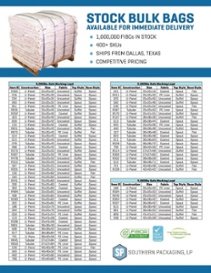Filling and Closing Open Mouth and Pasted Valve Multi-Wall Paper Bags
Nearly any industrial material that’s powdered, flaked, or granular can be packed into a multi-wall paper bag. Specific methods used for packing bags..
October 20, 2020
A Pasted Valve Stepped End (“PVSE”) bag, is a common industrial packaging style designed to package a wide variety of dry flowable products. Valve bags are packed on equipment that deposits material into the bag via horizontal filling spout. Valve packing equipment can range from manual, hand-spouted equipment to modern fully-automated equipment.
Manufacturers of quality valve bag packing equipment include: Premier Tech, Haver & Boecker, Choice Bagging, and Magnum Systems.
Valve bags are filled through an opening located in the top corner of the bag. Product is pumped or forced into the bag via air pressure, impeller, or auger. Properly sizing the bag is critical to achieving your operational objectives.
No matter what type of packing equipment you use, you will eventually run into packing problems. The perfect packing operation requires constant fine tuning and preventative maintenance to run efficiently and effectively.
.jpg?width=300&name=image1%20(3).jpg)
Product has not had the opportunity to dearate resulting in a rooster tail effect when the bag falls off the filling spout. Bag size being too small may also contribute to this problem.
Momentary delay to allow the product to dearate before the product is kicked off the fill spout. Also, turning down the air flow may improve this problem. A larger bag size should also be considered.
Filling tube is too short and will not let the end of the filling tube clear the insert causing:
Present the bag further onto the filling tube or increase the length of the filling tube.
Too much air on an air bagger will aerate the product which decreases bulk density of the material
Turn down air flow of the packing equipment
Bag Chair too high or too low will cause the bag to not fill properly, resulting in loss of volume or capacity.
Adjust the bag chair to up or down to achieve the desired fill capacity.
Signs of a bag that is too SMALL:
Signs of a bag that is too LARGE:
Properly sized valve bags should not appear too tight or too loose. A general rule of thumb is the amount of freeboard in the top of the bag should be equal to finger length. Freeboard is the distance between the top of the product and the top of the bag when the bag is placed upright.
Our multi-wall paper and poly valve bags are produced with state-of-the-art converting equipment in plants located domestically and abroad. Available in traditional kraft, high performance extensible paper, polyethylene film, or woven polypropylene, Southern Packaging offers a wide variety of bag styles to suit all your valve bag needs.
 Southern Packaging has grown to become one of the premier bulk packaging distributors in the country. We have succeeded by listening to our customers, identifying their needs, and delivering on our promises.
Southern Packaging has grown to become one of the premier bulk packaging distributors in the country. We have succeeded by listening to our customers, identifying their needs, and delivering on our promises.
Strategically located near Dallas, Texas, our company buys, sells, and delivers more than 1,100 different industrial packaging products to nearly 900 locations across the U.S.
Our substantial inventory includes all styles of FIBCs, paper bags, UN-certified bags, BRC & AIB food quality bags, Poly bags, BOPP bags, dunnage bags, and bulk shipping supplies.